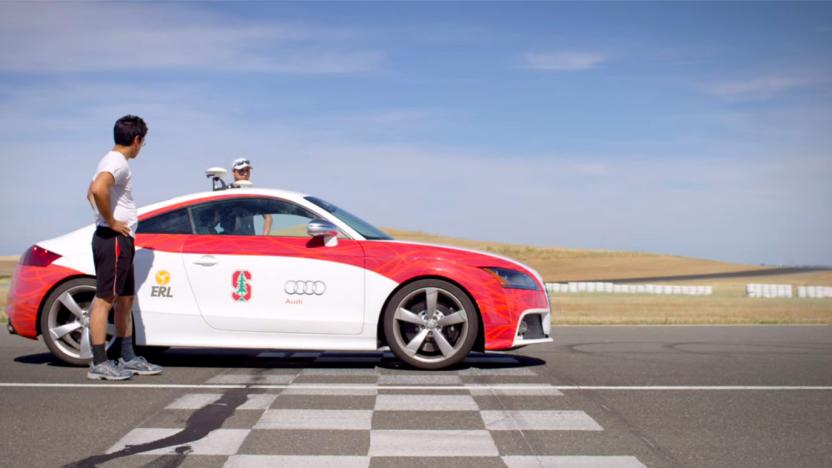stanford
Latest

Stanford's humanoid robot diver explores its first shipwreck
A group of underwater archaeologists exploring the sunken remains of King Louis XIV's flagship La Lune added a very special member to their dive team recently. OceanOne, a Stanford-developed humanoid diving robot with "human vision, haptic force feedback and an artificial brain," made its maiden voyage alongside human divers to recover 17th-century treasures from bottom of the Mediterranean.

ICYMI: Fire-starting drone, Stanford bird studies and more
#fivemin-widget-blogsmith-image-287454{display:none;} .cke_show_borders #fivemin-widget-blogsmith-image-287454, #postcontentcontainer #fivemin-widget-blogsmith-image-287454{width:570px;display:block;} try{document.getElementById("fivemin-widget-blogsmith-image-287454").style.display="none";}catch(e){}Today on In Case You Missed It: A prototype for a fire-starting drone was deployed in Nebraska last week, dropping small balls of accelerant to create a controlled burn over grasslands. The idea is that future firefighters could use UAVs like the University of Nebraska-Lincoln model to stop an out of control wildfire with drone-created fire breaks, or for other uses.

Stanford wind tunnel for birds could lead to more stable drones
Birds can navigate both urban and real jungles with ease even when they're facing moderately turbulent winds. If they could speak, we'd have already asked their secret. But since they can't, the Stanford School of Engineering built one of the most advanced wind tunnels in the world. It's where assistant professor David Lentink study them more closely in order to develop more stable drones. The tunnel has a turbulence generator that simulates different wind speeds and patterns, as well as high-speed cameras that record every flap of the birds' wings as they fly inside.

Napster co-founder's new institute aims to beat cancer
Sean Parker is known for many things: co-founding Napster, joining Facebook in its early days, starting charities and creating his share of technology startups. If all goes well, though, he'll also add "helped cure cancer" to that list. He just founded the Parker Institute for Cancer Immunotherapy, a $250 million effort to fight cancer by relying on the body's immune system. The organization will unite six universities (covering 40 labs and over 300 scientists), encouraging them to share research rather than compete. As Parker puts it, humanity is on the "bleeding edge" of what you can do with synthetic biology... it might just need a nudge to turn those findings into real-world treatments.

ICYMI: Brightest X-ray laser, 3D printing cartilage and more
#fivemin-widget-blogsmith-image-741239{display:none;} .cke_show_borders #fivemin-widget-blogsmith-image-741239, #postcontentcontainer #fivemin-widget-blogsmith-image-741239{width:570px;display:block;} try{document.getElementById("fivemin-widget-blogsmith-image-741239").style.display="none";}catch(e){}Today on In Case You Missed It: Stanford's National Accelerator Laboratory is upgrading a laser beam to make it the brightest X-ray laser in the world, enabling all sorts of as-yet unseen science. Popular Chinese phone maker Xiaomi makes a ceramic-backed phone that appears to be near indestructible. And medical researchers are using patient-derived, stem-cell cartilage to repair joints by 3D-drawing them when doing surgery, rather than harvest existing cartilage from elsewhere on the body. We'd also like to share this video of the cutest little BB-8 cosplay artist. As always, please share any great tech or science videos you find by using the #ICYMI hashtag on Twitter for @mskerryd.

World's most powerful X-ray laser will get 10,000 times brighter
If you think that Stanford's use of an super-bright X-ray laser to study the atom-level world is impressive, you're in for a treat. The school and its partners have started work on an upgrade, LCLS-II (Linac Coherent Light Source II), whose second laser beam will typically be 10,000 times brighter and 8,000 times faster than the first -- up to a million pulses per second. The feat will require an extremely cold (-456F), niobium-based superconducting accelerator cavity that conducts electricity with zero losses. In contrast, the original laser shoots through room-temperature copper at a relatively pedestrian 120 pulses per second.

ICYMI: AI bots, the wall-climbing drone and more
#fivemin-widget-blogsmith-image-676426{display:none;} .cke_show_borders #fivemin-widget-blogsmith-image-676426, #postcontentcontainer #fivemin-widget-blogsmith-image-676426{width:570px;display:block;} try{document.getElementById("fivemin-widget-blogsmith-image-676426").style.display="none";}catch(e){}Today on In Case You Missed It: Microsoft debuted a teenaged AI bot on Twitter to study human interactions and USC researchers are testing out bots with realistic faces for video chat support. Stanford's SCAMP is a UAV that can land and climb the sides of buildings. And the AxiDraw is a personal writing and drawing machine that will not screw up the decorative calligraphy on anything. We also enjoyed this survival video showing how to start a fire with a lemon. As always, please share any great tech or science videos you find by using the #ICYMI hashtag on Twitter for @mskerryd.

Stanford's SCAMP robot can fly, climb and perch on walls
Stanford's SCAMP looks like a quadcopter at first glance, but it can do much more than fly and hover in the air. Just like what its full name -- Stanford Climbing and Aerial Maneuvering Platform -- says, it can perch on and climb walls, much like an insect. A team from the university's Biomimetics and Dexterous Manipulation Lab took what they learned from previous projects to create the machine. One of those projects is Stickybot, a robotic, wall-climbing gecko.

Stanford's HIV and cancer test detects their presence earlier
A new technique to detect HIV and cancer developed by a team of Stanford chemists could save lives. It's a lot more sensitive than current screening tools, and hence has the power to detect diseases much earlier. As you know, the earlier an illness is detected, the more treatable it is. Like many other screening tests, this one also works by fishing for antibodies our immune system produces when it detects diseases using molecules with "flags" attached to them.

High-speed video shows how water lily beetles sprint on water
Water lily beetles are little speed demons, flitting from one pad to another at half a meter (1.6 feet) per second. Now, thanks to a study conducted by Stanford bioengineering assistant professor Manu Prakash and his students, the secret to its mode of flight has been unraveled. Turns out the insects (Galerucella nymphaeae) perform a routine before their flight, wherein they step on the water before lifting their legs one by one so that only their tips touch the surface. They then raise their middle legs high up in the air while their wings flap, making it look like they're sprinting across the surface.

ICYMI: Supersonic jetliner, the issue of sea sponge and more
#fivemin-widget-blogsmith-image-37467{display:none;} .cke_show_borders #fivemin-widget-blogsmith-image-37467, #postcontentcontainer #fivemin-widget-blogsmith-image-37467{width:570px;display:block;} try{document.getElementById("fivemin-widget-blogsmith-image-37467").style.display="none";}catch(e){}Today on In Case You Missed It: NASA gave Lockheed Martin $20 million to make a preliminary design of a supersonic jetliner that will break the sound barrier without a sonic boom. Stanford students are putting a self-driving Audi through a race course to improve AI algorithms. And MIT says it has found proof that sea sponges are the first animal on earth. Finally, Sweden's McDonald's has a new happy meal box that turns into a virtual reality headset. As always, please share any interesting science or tech videos, anytime! Just tweet us with the #ICYMI hashtag to @mskerryd.

Watch Stanford's self-driving Audi hit the track
Sending a self-driving race car around a track with nobody inside seems pointless -- there's no driver to enjoy the ride, and the car certainly isn't getting a thrill out of it. But the students performing research with Stanford University's Audi TTS test rig "Shelley" (not to be confused with Audi's own self-driving race cars) are getting a kick out of the numbers generated by the machine. "A race car driver can use all of a car's functionality to drive fast," says Stanford Professor Chris Gerdes. "We want to access that same functionality to make driving safer."

AI learns to predict human reactions by reading our fiction
A team of Stanford researchers have developed a novel means of teaching artificial intelligence systems how to predict a human's response to their actions. They've given their knowledge base, dubbed Augur, access to online writing community Wattpad and its archive of more than 600,000 stories. This information will enable support vector machines (basically, learning algorithms) to better predict what people do in the face of various stimuli.

6 of the world's wildest self-driving cars
By Cat DiStasio Last week, US officials said that the computer in Google's self-driving car can legally be considered the "driver" -- a decision that could serve as a stepping-stone to making driverless cars legal on American roadways. Companies like Google and Ford are busy testing self-driving car technology, and Tesla's Model S already has some autopilot features to assist drivers. But just how far will automakers take autonomous technology? Read on for six of the world's wildest self-driving vehicles, from a car that moves like a crab to a vehicle with a built-in bed.

Game algorithm could help win elections
There's a particular strain of game theory, Colonel Blotto, that many believe could predict the outcomes of everything from elections to sports matches. It asks two sides to distribute soldiers over a battlefield, and hands wins to whoever has the most soldiers in a given area. However, it has one glaring problem: there hasn't been a way to get a firm solution. Well, computer scientists have finally found that last piece of the puzzle. They've developed an algorithm that can solve the Colonel Blotto game, making it useful as a strategic tool whenever there's a one-on-one situation.

Stanford's 'Gecko Glove' makes Spider-Man climbing possible
Never let anyone crush your dreams. Last week the results of a University of Cambridge study spread through the news, claiming that the dream of Spider-Man-like abilities for humans is simply impossible. By their reasoning, sticky pads need to scale up in order to support increased weight, and as a result, the size of a gecko is about as big as a vertical climber can be. The only problem? An engineer at Stanford showed off a way around that problem back in 2014. Now Elliot Hawkes has dropped a diss track on YouTube firing shots at Cambridge and Stephen Colbert, showing off his climbing skills thanks to a "Gecko Glove."

How a novel class of microscopes has changed science
The laws of physics are simple. There's a hard 500 nanometer limit on the size of objects that you can see through a conventional, optical microscope because that's the "diffraction limit" of a wavelength of visible light. Anything smaller than 500nm looks fuzzy and out of focus because it is simply too small for the optics to properly focus on. Basically diffraction limits exist because the light that bounces off the object and into your eyeballs is larger than the thing you're looking at. The problem is magnified when there are multiple sub-500 nm items in your field of view because their "fuzziness" overlaps and further obscures the view. But that's where super-resolution fluorescence microscopy comes in.

Finally, a lithium battery that doesn't explode
When lithium-ion batteries overheat they expand and on some occasions, erupt into flames. It's the reason low-quality hoverboards keep exploding and can't be taken on flights. Thankfully Stanford researchers have created a Li Ion battery that shuts itself down when it overheats and turns itself back on when heat levels are at a safe level.

Near-infrared dye helps doctors spot cancer
Doctors regularly use dyes to highlight blood vessels that would normally be hard to see, but there's now the possibility that they'll use those chemicals to find cancer, too. Stanford researchers have developed a medical dye that emits light at a near-infrared wavelength, which produces sharper images that are visible at deeper skin layers. That, in turn, would let health care workers detect near-the-surface tumors such as breast cancer and melanoma. It leaves the body within a day, so you wouldn't have to worry about any long-term effects.

Scientists use 'spooky action' to mail electron messages a mile
Researchers at Stanford University announced Tuesday that they had successfully leveraged the "spooky" interaction of entangled electrons to send a message between them over a span of 1.2 miles. This is by far the longest distance that scientists have managed to send entangled particles and provides the strongest evidence to date that quantum computing can have practical applications.







